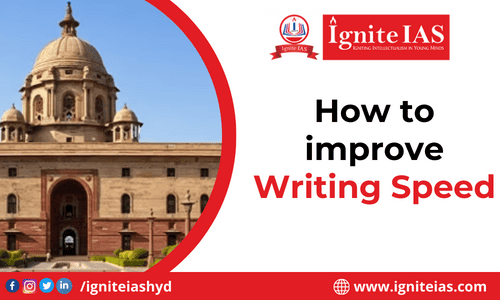Outline of the Article
1. Introduction to Writing Speed Improvement
– Importance in IAS Exam
2. Recognizing the Challenges
– Time Constraints in IAS Exam
– Maintaining Quality
3. Setting Realistic Writing Goals
– Balancing Speed and Accuracy
– Incremental Progress
4. Enhancing Typing Skills
– Importance in Modern Exam Formats
– Online Practice Platforms
5. Developing a Structured Writing Approach
– Effective Outlining
– Logical Flow of Ideas
6. Prioritizing Information Retrieval
– Efficient Note-Taking
– Quick Recall Techniques
7. Embracing Perplexity in Writing Practice
– Tackling Diverse Topics
– Expanding Vocabulary
8. Cultivating Burstiness in Writing
– Focused Writing Sessions
– Overcoming Writer’s Block
9. Balancing Specificity and Conciseness
– Providing Relevant Details
– Avoiding Information Overload
10. Writing in a Conversational Style
– Engaging the Reader
– Creating Interest in Exam Evaluators
11. Utilizing the Active Voice
– Enhancing Clarity
– Creating Impactful Sentences
12. Keeping It Simple Yet Articulate
– Clear Expression of Ideas
– Avoiding Unnecessary Complexity
13. Analogies and Metaphors in Descriptive Writing
– Capturing Imaginations
– Making Content Memorable
14. Strategies for Overcoming Common Writing Challenges
– Handling Time Pressure
– Quality Control Techniques
15. Conclusion: Mastering Writing Speed for IAS Success
– Recap of Strategies
– Encouragement for Aspirants
How to Improve Writing Speed
Introduction
Improving writing speed is a crucial skill for IAS aspirants facing time constraints in the exam hall. In this article, we will explore effective strategies to enhance your writing speed while maintaining the quality required for success in the IAS exam.
Recognizing the Challenges
IAS exams demand not just knowledge but the ability to express it coherently within a limited time frame. Recognizing the challenges of time constraints and the need to balance speed with accuracy is the first step towards improvement.
Setting Realistic Writing Goals
Balancing speed and accuracy is an art. Set realistic writing goals that challenge you to write faster without compromising the quality of your content. Progress incrementally to avoid overwhelming yourself.
Enhancing Typing Skills
In the age of technology, typing skills are as crucial as writing by hand. Practice typing on online platforms to adapt to modern exam formats, ensuring you can convey your ideas efficiently.
Developing a Structured Writing Approach
A well-structured approach is key to efficient writing. Learn effective outlining techniques and focus on maintaining a logical flow of ideas to make your writing more coherent.
Prioritizing Information Retrieval
Efficient note-taking and quick recall techniques are vital. Practice retrieving information swiftly to enhance your ability to organize your thoughts and express them on paper during the exam.
Embracing Perplexity in Writing Practice
Challenge yourself by tackling a diverse range of topics. Embracing perplexity in your writing practice not only broadens your knowledge but also expands your vocabulary, making you a more versatile writer.
Cultivating Burstiness in Writing
Burstiness, characterized by focused and intense writing sessions, is a valuable skill. Cultivate techniques to maintain burstiness, overcoming writer’s block and ensuring your writing is both swift and impactful.
Balancing Specificity and Conciseness
Provide relevant details without overloading your writing. Balancing specificity and conciseness ensures your answers are comprehensive without being unnecessarily lengthy.
Writing in a Conversational Style
Engage the reader through a conversational writing style. This not only makes your writing more enjoyable to read but also creates a connection with exam evaluators.
Utilizing the Active Voice
The active voice enhances clarity and makes your writing more impactful. Utilize the active voice to create sentences that are direct and assertive.
Keeping It Simple Yet Articulate
Clear expression of ideas is crucial. Keep your writing simple and to the point, avoiding unnecessary complexity that may confuse both you and the reader.
Analogies and Metaphors in Descriptive Writing
Make your writing memorable by incorporating analogies and metaphors. These literary devices capture imaginations and add a creative touch to your descriptive writing.
Strategies for Overcoming Common Writing Challenges
Learn to handle time pressure effectively. Implement quality control techniques, such as proofreading, to ensure your writing meets the required standards.
Conclusion: Mastering Writing Speed for IAS Success
In conclusion, mastering writing speed is an ongoing process that involves setting realistic goals, embracing diverse writing challenges, and cultivating burstiness. As you embark on this journey, remember that improvement takes time, and each small step brings you closer to success in the IAS exam.
FAQs on Improving Writing
1. How can I balance writing speed and quality during practice sessions?
– Focus on incremental improvement, set realistic goals, and prioritize maintaining quality even as you aim to increase speed.
2. Are there specific typing platforms recommended for IAS aspirants?
– Online platforms like TypingClub and KeyHero are beneficial for IAS aspirants to enhance their typing skills.
3. How can I overcome writer’s block during exams?
– Cultivate burstiness by practicing focused writing sessions during your preparation. Break down the writing process into smaller tasks to overcome writer’s block.
4. Should I focus more on typing or handwriting practice for IAS exams?
– Both skills are important. While typing is crucial for modern exam formats, handwriting practice is still relevant for essay-type questions.
5. What strategies can I use to proofread effectively within time constraints?
– Develop a systematic approach, prioritize checking for clarity and coherence, and practice proofreading within a time limit to enhance efficiency.




